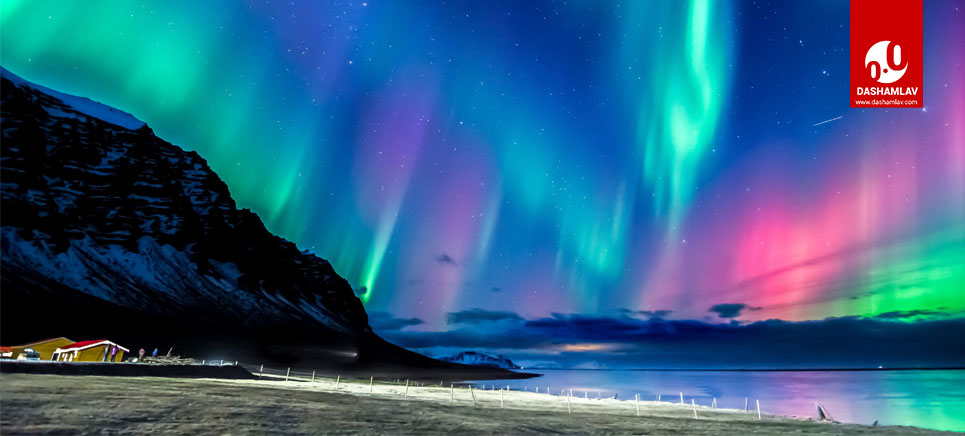Auroras are spectacular luminous natural lights visible in the sky mainly during the peak of winters near the poles of the Earth. These lights are a regular phenomenon in the regions of higher latitudes in both the hemisphere. At times, they are also witnessed in latitudes as low as 35-40 degrees.
While this luminous phenomenon occurs in both the hemisphere near magnetic poles of the Earth, it has been given different names for each pole. When aurora occurs in the Northern Hemisphere, it is called Aurora Borealis or Northern Lights. Similarly, in the Southern Hemisphere, it is known as Aurora Australis or Southern Lights.
Aurora Borealis is commonly seen from countries like Norway, Canada, Alaska (United States), Scotland (United Kingdom), Iceland and Finland.
Interestingly, the phenomenon of aurora is not limited to Earth. It is also experienced by other planets of our solar system. In 2016, a new type of aurora was discovered on Mars by NASA’s MAVEN spacecraft. It is called Proton Aurora as it forms from the interaction of protons (from the Solar Wind) and hydrogen present in Martian atmosphere. Similarly, Jupiter and Saturn also experience the aurora phenomenon.
What causes the aurora?
When Sun’s corona (outer layer) reaches a temperature as high as 1.1 million degrees Celsius, it is unable to hold the rapidly moving charged particles present in it. As a result, the Sun releases a stream of these energized particles in the form of Solar Wind. These fast-moving charged particles are mainly electron and protons. When these energized particles approach our Earth, the magnetic force of Earth channelizes these particles towards the magnetic poles of the Earth in both the hemispheres.

When these particles enter the uppermost layer of the atmosphere, collisions take place between these particles and atmospheric gases like oxygen and nitrogen present in the region. These collisions leave the gas molecules in an excited state. The excited gas molecules (mainly oxygen and nitrogen) release photons and emit light while returning back to their normal state. Our eyes detect aurora only when billions of molecules collide and release a significant amount of photons.
Ultraviolet & infrared radiations are also present in aurora
The excited gas molecules present in Earth’s atmosphere also emit ultraviolet rays. However, it is not possible for our eyes to detect them without any satellites or special camera. Ultraviolet Auroras are also seen in other planets like Mars and Jupiter.
Can Aurora be seen in daylight?
Aurora is extremely subdued in comparison to the sunlight. This is the reason why it is not detected with our eyes during the daytime.
Why Aurora has different colors?
Auroras are nothing less than a painting in the sky. Beautiful luminous colors dancing in the sky mesmerize the observers. Green, yellow, red, pink, purple and blue – are common aurora colors.
The color of the aurora depends on two factors:
- Type of gas molecule with which collision of particles take place; and
- Amount of energy exchanged.
Oxygen is known for commonly emitting greenish-yellow or reddish-pink light. Nitrogen, on the other hand, generally emits blue-purple light.
What causes the different shapes of the aurora?
The bright lights of the aurora appear in many different shapes and forms. The shape of aurora largely depends on the place from where you are observing it as well as the shapes of luminous parts of the atmosphere. The exact scientific reason behind the different aurora shapes, however, is yet to be clearly understood.
Some of the most common aurora shapes are: arcs, bands, pillar and corona. At times, auroras also appear in a combination. As we get closer to the magnetic poles, geomagnetic activity increases. Magnetic poles are home to more active aurora conditions resulting in a combination of more than one shape.
What are auroral ovals?
The phenomenon of aurora occurs in a ring-shaped region surrounding the two magnetic poles of Earth. These regions are known as auroral ovals.
Use the citation below to add this article to your bibliography
"Aurora Borealis (Northern Lights): Meaning and Causes." Dashamlav.com. Web. 13 June 2025. <https://dashamlav.com/aurora-borealis-northern-lights-meaning-cause/>
Dashamlav.com, "Aurora Borealis (Northern Lights): Meaning and Causes." Accessed 13 June 2025. https://dashamlav.com/aurora-borealis-northern-lights-meaning-cause/
"Aurora Borealis (Northern Lights): Meaning and Causes." (n.d.). Dashamlav.com. Retrieved 13 June 2025 from https://dashamlav.com/aurora-borealis-northern-lights-meaning-cause/
